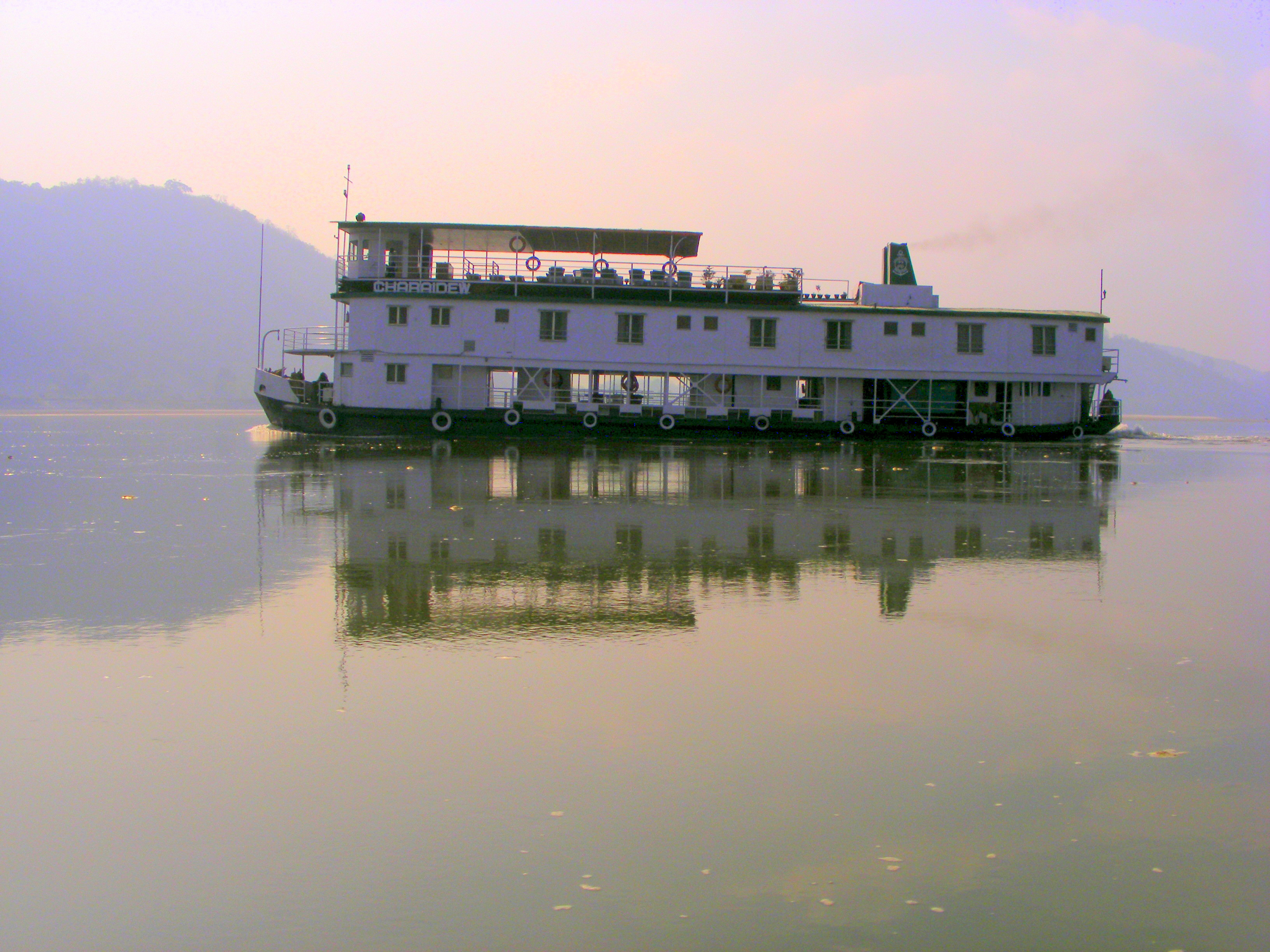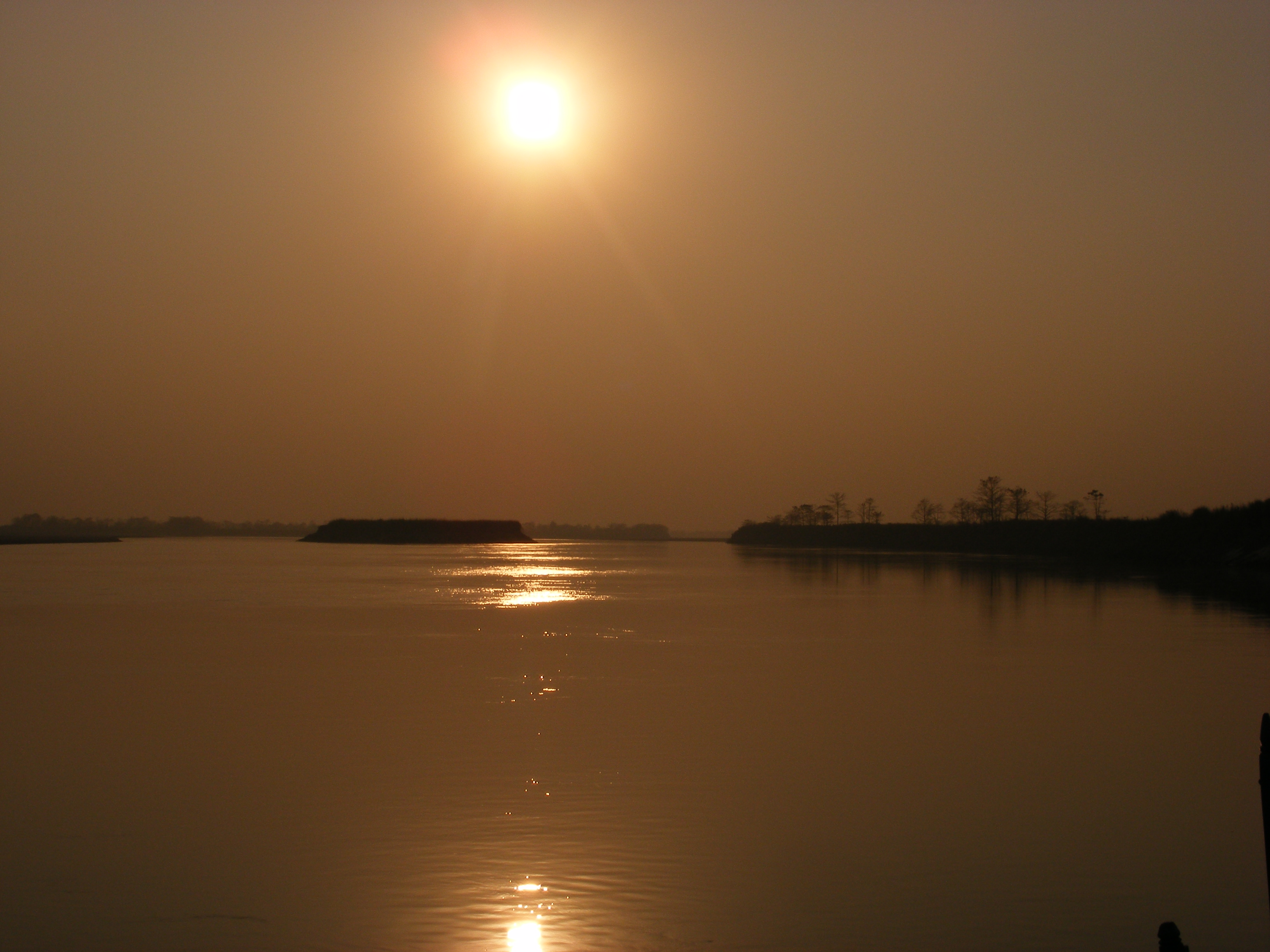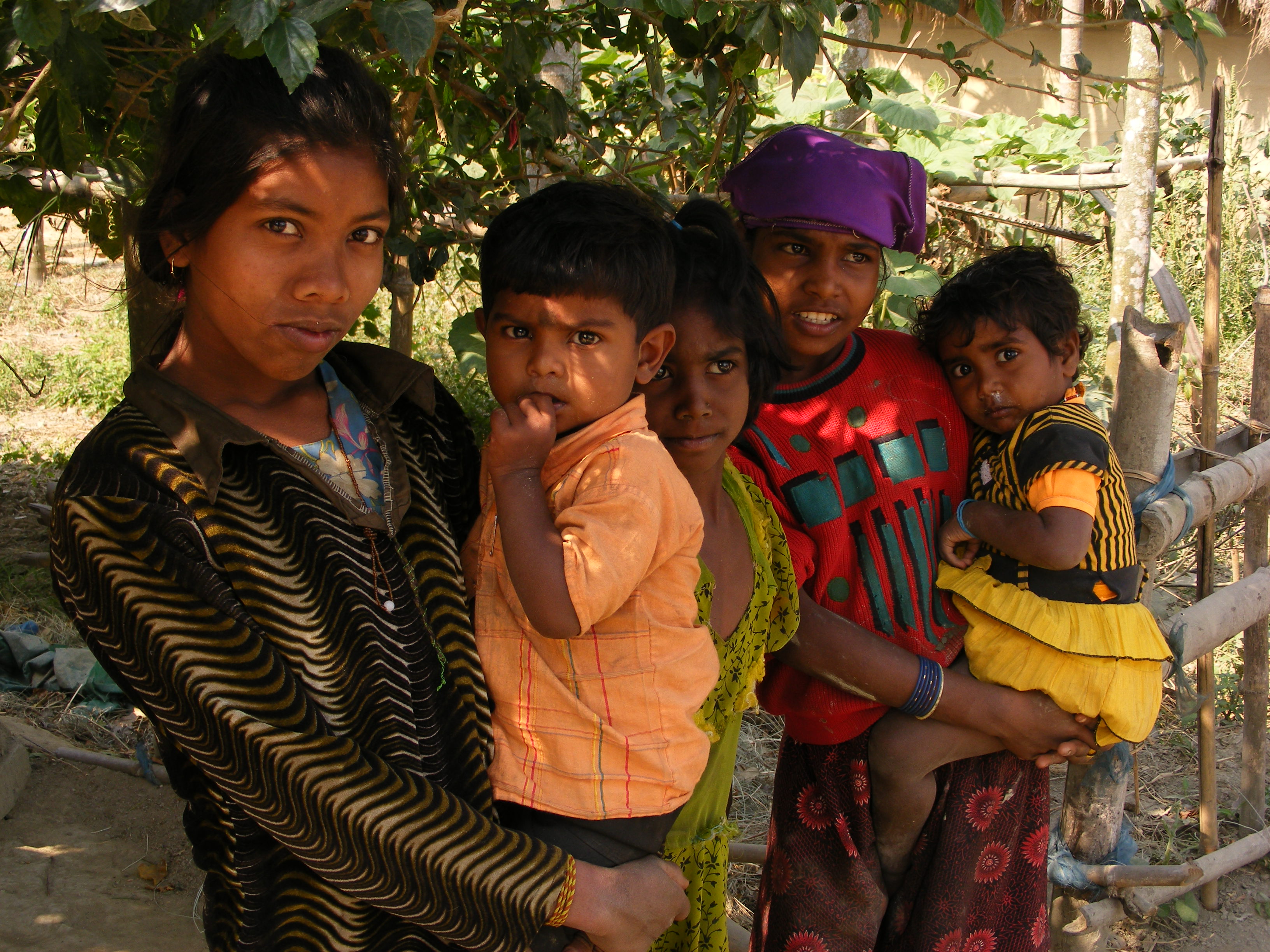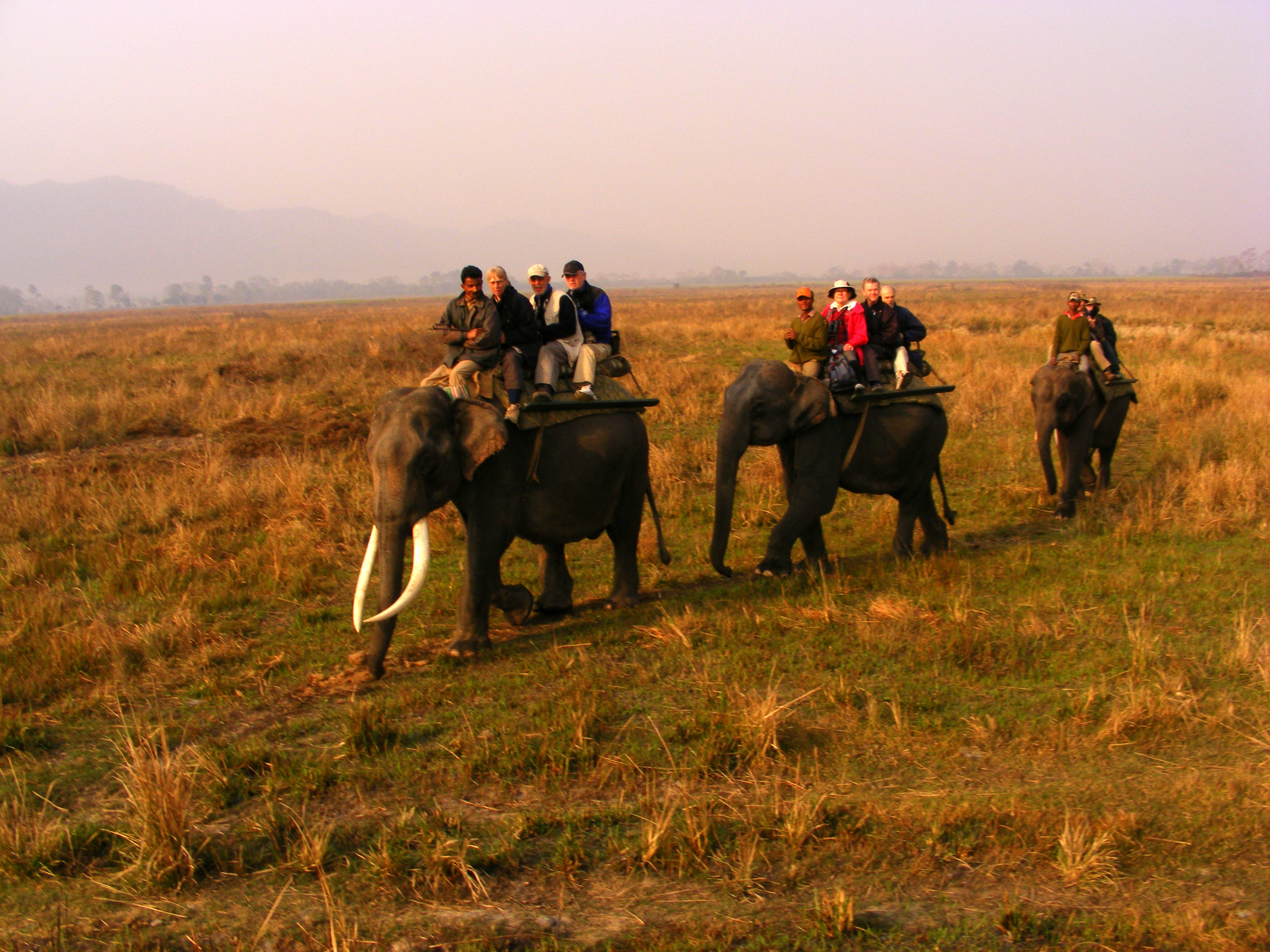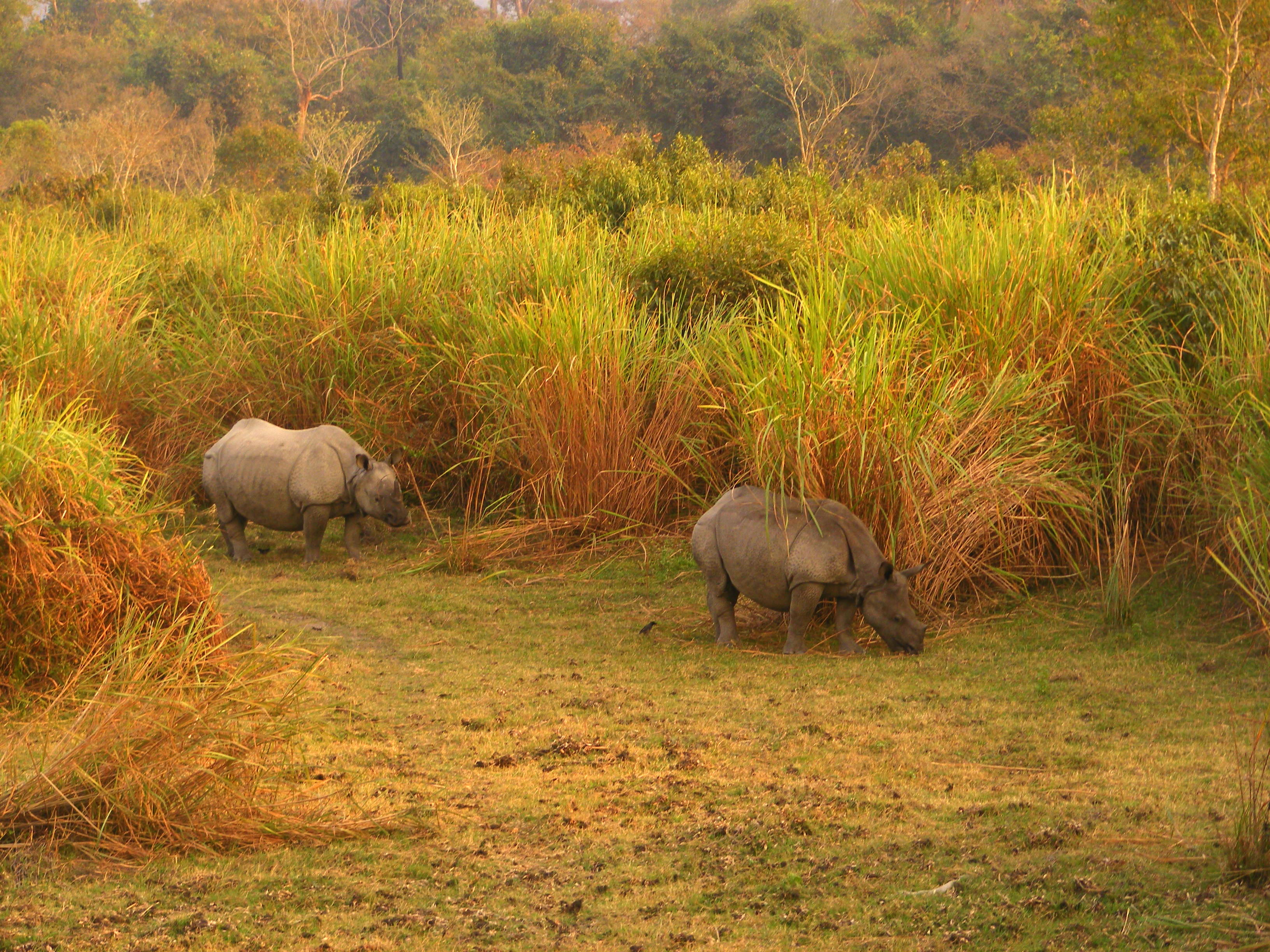When the aircraft arrived over Guwahati and was circling prior to touch down I could see in that silvery light of the early morning a huge river – indeed, the mighty Brahmaputra. This sacred river which is the only male sacred river in Hindu mythology is considered the ‘son of Brahma’ and I was excited. In all my life and travels inIndiaI had never yet been close to or on theBrahmaputra. In my childhood one did not travel except for family transfers and when I was a teenager after the Chinese Army invaded Assam it became a prohibited place; now however the whole North East of India is really trying to place itself as a good and different tourist destination and so here I was about to touch down in Assam for the very first time!
The airport at Guwahati is clean and pleasant and we were met by a smiling Dipankar on behalf of Assam Bengal Cruises. Guwahati in the early morning on a Saturday was a sleepy place and quiet and with very few people around so we – that is Graham and I – were able to see a lot and Dipankar was determined to have us driven around and appreciate his city. It reminded me of a lot of Indian cities of my childhood when the population had not yet soared to stratospheric levels and the wide streets and municipal buildings are gracious and there is aStrandalongside the river. The population is 2.5 million people who were not much in evidence that morning.
Our first stop was up the Nilachal Hill to see the holy Kamakhya Temple. Yes, well with respect I am always more appreciative of what are known as ‘unliving temples’ and heritage site temples because I in no way want to watch animals being sacrificed and abhor that sort of voyeurism. Interestingly later in the day one of the female tourists on the cruise went on at some length about how awful it is to enact animal sacrifice in this day and age….and though we had only just met I asked politely ‘well then why did you watch?’
There is a note about this temple which people may find of interest – I did take plenty of photographs of buildings, holy men and devotees and live animals – I think Guwahati is the place on which the imaginary Surpur is based in Gita Mehta’s wonderful though tragic book Raj. I had only just managed to read that book whilst in India and there were so many descriptions that seemed to fit it – Graham then read it on my insistence and we both agree that it is a very fine book and though fiction very informative in so many ways.
So, having paid my respects to the temple we went to somewhere that meant infinitely more to us both; The Guwahati War Cemetery for those who died in World War II. Graham and I were deeply moved by this peaceful well-kept place and spent a long time paying our respects to the Fallen. What especially struck us and made us feel a little better is that there was no deference or preferment – the dead from the rank of brigadier down to the waterman in all religions are laid there; Christian, Hindu, Muslim, Jew. All these souls interred in a peaceful garden on a slight slope and in the morning sunlight it was very moving.
For those of my generation whose late fathers fought in that war and returned safely it was a time to give thanks as well for what we had had – our childhoods and stability and security which so many others were deprived of – and have we learnt, no, but we remember the end of that war with respect. The Cemetery Keeper is a nice young man and we said our good byes and went to join the ship.
We arrived at the ghat and boarded the MS Charaidew by embarking on her country boat which she takes with her on her journeys and from there we embarked on the ship herself. We were early and received a very fine welcome and were taken to our cabin and we asked for breakfast. We had woken at 0400 hours and had light refreshment in Kolkata at the ITC Sona, brought by a thoughtful butler, but now it was after 10.00 hours and we were hungry and thirsty. What better, fresh orange juice, papaya with nimbu (lime) followed by tomato omelettes and goodAssamtea. Pratick is the very friendly Manager of the cruise and he has charming Staff who all hail from the north eastern states and were so friendly and helpful and eager to please.
The top deck of the Charaidew is where one spends one’s time relaxing and enjoying the changing scenery of the river and its banks and life – both human and animal. It is spacious with cane chairs in white with green cushions and I soon realised that is the Assam Bengal livery – green and white. The cabins are currently also decorated in those colours and everything on board has been manufactured either in Assam or nearby using local materials such as bamboo for panelling and floors and furniture and local soft furnishings. The ensuite shower room has an excellent shower which produces scalding hot water with power so one might be ‘adventure cruising’ but not having to do without the essentials like a flush w.c. and good vanity basin provided with toiletries and the shower.
There is a ‘dhobi’ (laundryman) on board and clothes are returned the same day in excellent order – but then I would not ask him to process something too special and delicate. The beds are comfortable and serviced daily and bottled water is provided, as is a torch because at 23.00 hours the generators are switched off and there is no current for electric lights which results in perfect tranquil peace moored up to a huge silt bank of the river. The generators are switched on at about 0600 hours every morning. There is an electric plug for hairdryers which is essential.
The lounge is a pleasant area with a bar that operates in the evening and on the top deck there is usually fresh tea and coffee served and cool drinks available in the chill cabinet on an ‘honesty box’ arrangement for the drinks. The dining room is on the lowest deck and guests are seated as they wish on long tables with buffet style service. The food to our way of thinking was outstanding, given the limitations of being on an old river boat on theBrahmaputra. The Chefs produced excellent food with their versions of western cuisine but particularly with lovely curries and accompaniments. All the guests thought like us and the staff was very attentive and appreciated that we complimented them on the food.
However, I am getting ahead of myself. I am now going to return to the River! India is a land of rivers and many of them are considered sacred rivers. I think immediately of the Ganges (the Ganga), the Yamuna, the Godavari, the Chambal, the Narmada, the Tungabhadra, the Kali, the Bhagirathi, the Mandovi, the Periyar and the Cauvery and the Krishna – all rivers that I have known through living near them or visiting different parts of India. But the Brahmaputra, this is big.
The Brahmaputra originates as the Yarlung Tsangpo in the Jima Yangzong glacier near Mount Kailashin the northern Himalayas. It then flows east for approximately 1,800 kilometres (1,200 miles) at an average height of 4,000 metres (13,000 ft). This makes it the highest of the major rivers in the world and at its easternmost point it bends around Mount Mancha Barwa, and forms the Yarlung Tsangpo Canyon which is considered the deepest in the world.
The river enters Arunachal Pradesh and it makes a very rapid descent from its original height in Tibetand finally appears in the plains where it is called Dihang. It is then joined by two other major rivers the Dibang and Lohit. From this confluence it becomes very wide and is called Brahmaputra. It flows through the entire state of Assamand is sometimes as wide at 10 km (6.2 miles) and in flood it can reach 22 km in width.
Definitely to the observer it seems to be much less polluted than the other major rivers of India but it also has challenges in that the petroleum refining units contribute considerable pollution along with riverside industries of all types. The main problem of the Brahmaputra is that it constantly floods and even more so now with so much deforestation.
The results of these almost annual floods is devastation and loss of lives. By the point at which it conjoins with the Ganga it flows into the huge Ganges Delta – the largest delta in the world – which serves both India and Bangladesh and in its lower course the river is both a creator and a destroyer depositing huge quantities of fertile soil, but also causing disastrous floods that wash away everything in their path as is often seen in Bangladesh particularly. For me the huge white silt banks of the river were a new experience and astonishing in their size; at night in the moonlight one could be forgiven for thinking they were icebergs not silt/sand!
Lounging on the top deck in a rattan chair or on the wooden loungers placed for maximum sun one just watched the world go by at a sedate pace. On my first morning I had hardly sat down when I saw a large grey living beast in the water and realised excitedly that it was a River Dolphin. Subsequently we saw masses of them but I am afraid however much I tried my photography of these fast moving creatures did not work but it was such a pleasure to see them and we decided that actually like most others of their kind they like to show off and are inquisitive. Knowing how depleted theGangais of the Gangetic Dolphin it was really heartening to see so many on so many occasions. That first evening as the sun moved into a glorious sunset and the dolphins played and the boat was finally moored to a silt bank it was very special.
The second day started early for me with a cup of tea and I went up to watch the sunrise. Later after breakfast we cruised upstream and then the party disembarked on to the country boat and went off the visit a typical Assamese village. This was both interesting and good fun and the villagers made us shyly welcome and some little boys showed off (as little boys are prone to do anywhere in the world) and we saw that latrines had been built for the village houses to counteract the habit of leaving human waste all over the place. This will be a hugely beneficial addition to village life as the incidence of various diseases will automatically fall I imagine with better hygiene – it is always sobering in India to see this sort of development and realise that the youngsters own cell phones before they have been introduced to a flush w.c.
Most of the guests, indeed I think all of them, were having a wonderfully relaxing time and we were taken on a sunset trip to see the outskirts of Orang National Park, and then very early the next morning on the fourth day we visited Orang National Park arriving by the country boat and scrambling up the silt bank. The jeeps were waiting and we had a comprehensive tour of the park but without too many dramatic sightings. However for Graham and me the memory will be of the abundance of scarlet silk cotton trees and indeed some with yellow and others with orange flowers. These have featured in our childhoods and were looking marvelous. There was some good bird life and a few deer but nothing really dramatic though it was enjoyable. It was thoughtful that tea and coffee was provided on the country boat at the end of our jeep safari when we were all thirsty.
On day five we cruised to Tezpur and visited the 6th century Da Parbatia temple and then explored the town by cycle rickshaw. The municipal gardens called Cole Park have several medieval stone carvings saved from sites all over the region. The garden is very well cared for and there was an absence of litter and it was a pleasant experience.
One of the highlights of the trip for us was the very excellent barbecue that the staff arranged on the sand and I think everyone enjoyed that. The next morning we went for a short walk at sunrise before casting off. On day six we continued upstream and passed below a huge modern bridge across the width of the river to moor at Steemer Ghat (which is oddly spelt as you might observe).
In fact it was quite a wild place with a small village nearby the gardens of which were filled with bright scarlet ram shorn poinsettias and in the afternoon we drove to Kaziranga’s Eastern Range for a jeep safari; this is little visited and though enjoyable with one or two good sightings of rhino was a little disappointing. Of course the silk cotton trees were there flowering in abundance! The next morning we set out early and arrived for an elephant ride which was excellent at the Central Range.
We saw plenty rhino close up and other animals and enjoyed the interaction with the domestic elephants and their calves. We were then driven to a lodge on a nearby tea estate for an excellent breakfast which had the most sublime puris as part of the menu. After a rest and breakfast we then visited a tea estate and the shop nearby that sells the various delicious types of tea.
CRC means curled rolled and chopped and orthodox is the other variety. Graham and I are enthusiastic tea drinkers and like leaf tea particularly and now that teapots are sold with fine mesh baskets internally it is so easy to return to leaf tea. I recall with amusement how people of one’s parents’ generation initially disapproved of tea bags – and with good reason because most of them seem to have the dust of tea in them whereas some of us grew up with really top quality tea being served daily.
We then visited another tribal village where the livestock was plentiful with somnolent pigs and their piglets and poultry and kid goats all interacting with young children and shy mothers around their homes.
Heading back to the Diphlu River Lodge providing much-needed top-class accommodation at Kaziranga National Park, which is of course a World Heritage Site. The position of the lodge is second to none: only the boundary river separates its extensive grounds from the National Park itself, and the jungle views are exceptional.
I saw a coven of Adjutant Storks, may be a coven is not the right description but they looked amusing all standing huddled together! Assam Bengal Navigation runs the lodge to the same exacting standards of the river cruises on the Brahmaputra and the Hugli, while their Bansbari Lodge atManasNational Parkon theBhutanborder offers simpler but comfortable accommodation for another wildlife experience. I loved these particular lodges as the interiors were really well thought out with good touches like – a jug of fresh cold milk in the bedroom’s fridge – I talk constantly about this to luxury properties as most of us discerning tea or coffee drinkers hate UHT in little packets! It was an eureka moment at which Graham chuckled.
KAZIRANGA NATIONAL PARK, ASSAM
The National Park covers about 430 sq km, bordered on the north by the Brahmaputra River and on the south by the Karbi Anglong hills and is home to the endangered Rhinoceros unicornis; the park has the largest number of one-horned rhinoceros in the world which roam its swamps, grasslands with tall thickets of elephant grass and areas of mixed deciduous and tropical semi-evergreen forest. It is home to a wide variety of other animals and birds, and the open vistas make it relatively easy to see many species of wildlife in a day; naturally I would have loved to spot a tiger but that did not happen though other Charaidew passengers have been lucky in the past. I had enjoyed my two visits; the one to theEasternRange and the early morning elephant ride in theCentralRange but that afternoon was the best.
Four of us set out for the Western Range with Babu the naturalist. Everyone else seemed to want to take it easy. When we arrived at the Park one of our party asked Babu ‘So tell me…how many rhinos will we see now?’ Babu paused and said laconically ‘Sir maybe 35 to 40….’ At which we four looked at each other and talked about bets and exaggeration.
Yes, well, Babu knew what he was talking about and we had the most glorious and successful afternoon in which we saw a number of wonderful animals including a monitor lizard, wild elephants and swamp deer, wild buffalo, a number of different types of eagles and kites and then rhino.
Oh yes, rhino and rhino and rhino – in the distance, in the nearby swamp and really close up. In all we saw 36 rhino whilst in the park and on the way home we spotted two more. You can imagine Babu was grinning, and so apparently was I when I returned and blurted it all out to another friend. For us the vista of rhino and buffalo and swamp deer with the odd wild elephant near a shallow lake as the sun was setting is a special memory that gave the four of us great pleasure at the time; Kaziranga is not easily reached and needs dedication on the part of the traveller but well worth the effort.
That evening was the last one for most of us and so a special effort was made by the Staff to look very beautiful or handsome according to gender and so we the guests also put on glad rags and had a superlative dinner with beautiful menu on each place setting. This cruise was a splendid experience and one I recommend; if possible for the wildlife enthusiast I would suggest a couple of nights at Diphlu River Lodge at the end before travelling to your onward destination. As it was most people took the transport back to Guwahati the next morning but we moved onward to Jorhat by car for one night.
More photos of the trip can be found here: https://plus.google.com/photos/105833357733916819450/albums/5450792094692793057.
Aline Dobbie is an author of four books on India and a travel writer. She lives in Scotland but travels widely throughout the year with an annual visit to India where she was born & grew up. Aline’s earlier life was in the corporate world but now lives a rural life with emphasis on travel, gardening, cooking, and family. India, South Africa, England, Scotland, Greece and other lovely places are a constant delight to her.

